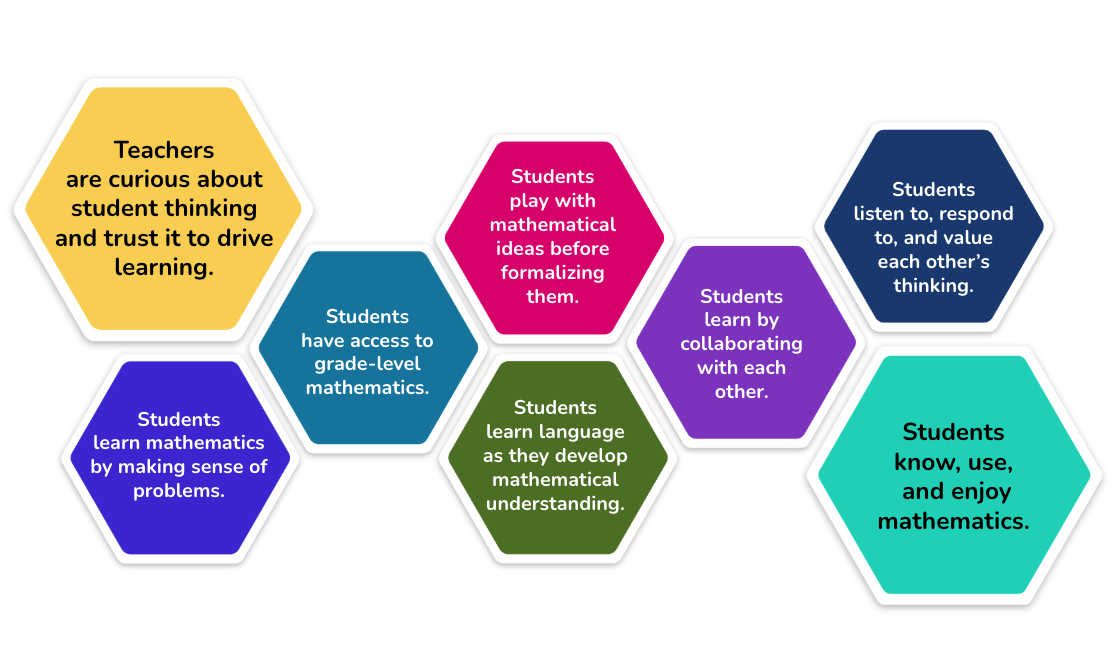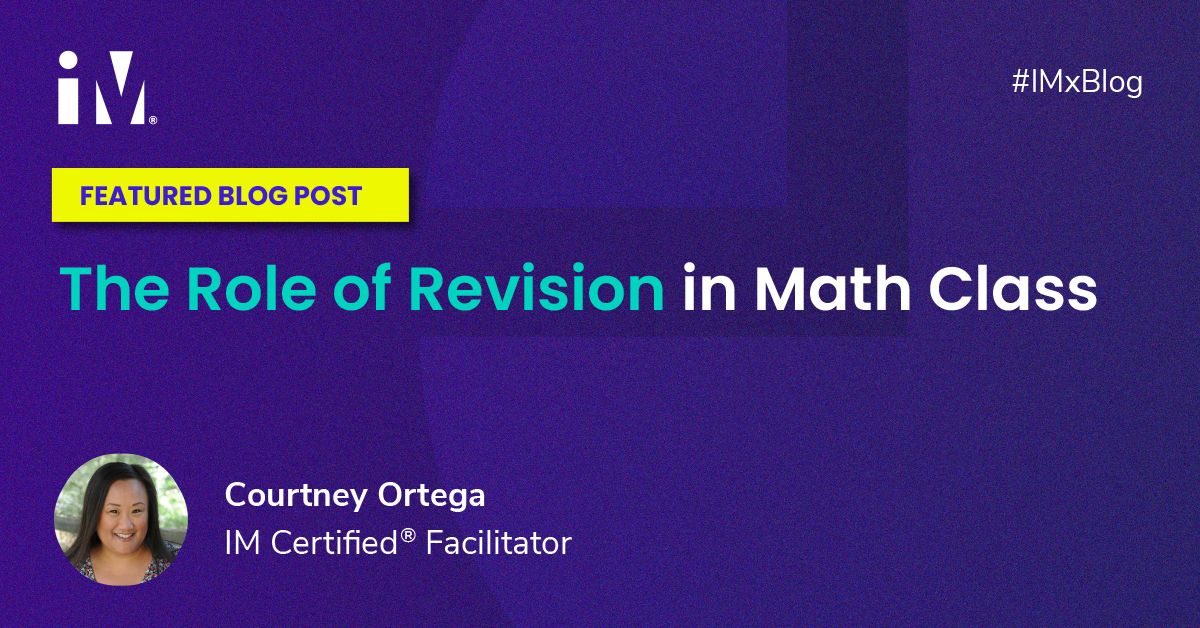By Courtney Ortega, IM Certified® Facilitator
Learning takes time. Students make connections, deepen their understanding, and address misunderstandings. Along the way, it can make the learner feel vulnerable.
“When we learn, we actively work to make sense of an idea that does not make sense to us yet,” writes Amanda Jansen in Rough Draft Math (Stenhouse, 2020).
In a safe space for learning, students share what Jansen calls rough draft thinking—unfinished, in-progress ideas that are open to revision. This vision aligns perfectly with the goals of an IM classroom, and there are structures embedded in IM® K–12 Math that support this work, giving students opportunities to rethink, refine, and deepen their mathematical understanding.
Revision is a Critical Component of Problem-Based Teaching and Learning
The figure below illustrates the elements of problem-based teaching and learning that underpin IM Math.

In an IM classroom, teachers trust student thinking to drive learning, and students are given space to develop ideas. As students play with mathematical ideas, they move toward formalizing them. They learn by collaborating with each other: listening to, responding to, and valuing each other’s thinking.
As students are doing this hard work, their mathematical understandings are constantly developing. Hearing a question asked by another student or the teacher may cause them to reconsider their own ideas. Listening to another student share their approach may inspire them to revise their reasoning or strategy.
One way this shows up in IM Math is through Math Language Routine 3: Critique, Correct, and Clarify. This routine asks students to examine a piece of work—individual or class-generated—that may be incomplete, unclear, or incorrect. Students identify areas for improvement, rewrite a stronger response, and clarify the author’s intention.
This process helps students:
- Replace vague language with precise terminology (e.g., “the equation representing miles per hour”).
- Address their own misconceptions.
- Gain ownership of their reasoning and writing.
Through collaboration and revision, students are able to deepen their understanding in ways that lead to agency and ownership in their work. They gain tools for analyzing and strengthening their own writing moving forward.
Supporting English Learners Through Revision
Revision also promotes access for English learners. Teachers of English learners must hold high expectations for content learning by amplifying rather than simplifying students’ use of language. Some educators are tempted to reduce expectations to ensure “success,” simplifying the text that students need to read, or simplifying the written or verbal output that we expect students to produce. Instead, we should find as many ways as possible to present the learning goals in different ways—a strategy Pauline Gibbons calls “message abundancy.”
In IM Math, Math Language Routine 1: Stronger and Clearer Each Time provides English learners (and all students) with “message abundancy.” Students write a first draft response. Then they engage in a series of structured pair meetings where they share, refine, and clarify their response through conversation. After their final pair meeting, students will have a response that is stronger and clearer than their initial draft.
Through repeated opportunities to share their ideas, hear other ideas, and be pressed for details or clarification, students have many chances to process and comprehend the mathematical ideas. The result? Students’ work becomes stronger and clearer, and their understanding of the learning goals deepens.
Revision as a Culturally Sustaining Practice
As teachers, we want to cultivate culturally sustaining practices that affirm all students as meaningful contributors within the classroom. Zaretta Hammond’s book, Culturally Responsive Teaching and the Brain, emphasizes giving students authentic opportunities to process content, using methods that honor oral traditions and reposition the teacher-student relationship as a partnership.
Math Language Routine 2: Collect and Display puts this into practice. During this routine, the teacher circulates the IM classroom, capturing student language and ideas on the board. During the synthesis discussion, the teacher amplifies the words, phrases, and diagrams that they heard and saw students using. This routine allows students to engage in authentic, organic conversation while the teacher captures thinking for the visual display.
The partnership between teacher and students is strengthened when the students’ own words and ideas are used to drive the discussion. In addition, students experience ownership of both their original ideas and the refined ideas that result after the discussion. And as they replace familiar language like “plug it in” with more mathematical language like “substitute,” students also build meta-awareness about how they talk and write about their mathematical ideas.
Conclusion
Revision plays so many important and nuanced roles in math class. Students:
- Deepen their conceptual understanding as they study their work, see their own ideas captured in writing, and change their minds many times during a peer discussion.
- Develop meta-cognitive skills that they can apply to challenging problems in the future.
- Strengthen their communication by clarifying and refining their own ideas.
Through peer discussion, structured routines, and reflective practice, revision becomes a powerful tool for learning, ownership, and agency.
Next Steps
What role does revision play in your classroom? How do you or will you intentionally create opportunities for students to reconsider and refine their thinking through peer review or class discussion? How might this impact student success in formative assessments or cool-down activities?
Learn more about the purpose and structure of the math language routines embedded in IM K–12 Math here.
Citations
Jansen, Amanda. Rough Draft Thinking. Stenhouse, 2020.
 Courtney Ortega
Courtney Ortega
IM Certified® Facilitator
Courtney Ortega is a National Board Certified teacher and taught math and science in middle schools and high schools across the Bay Area before transitioning to district leadership. Courtney has developed professional learning systems grounded in lesson study, the TRU math framework, and site-based content coaching. She believes in nurturing collaborative structures that empower teams of teachers to engage in student-centered inquiry.
